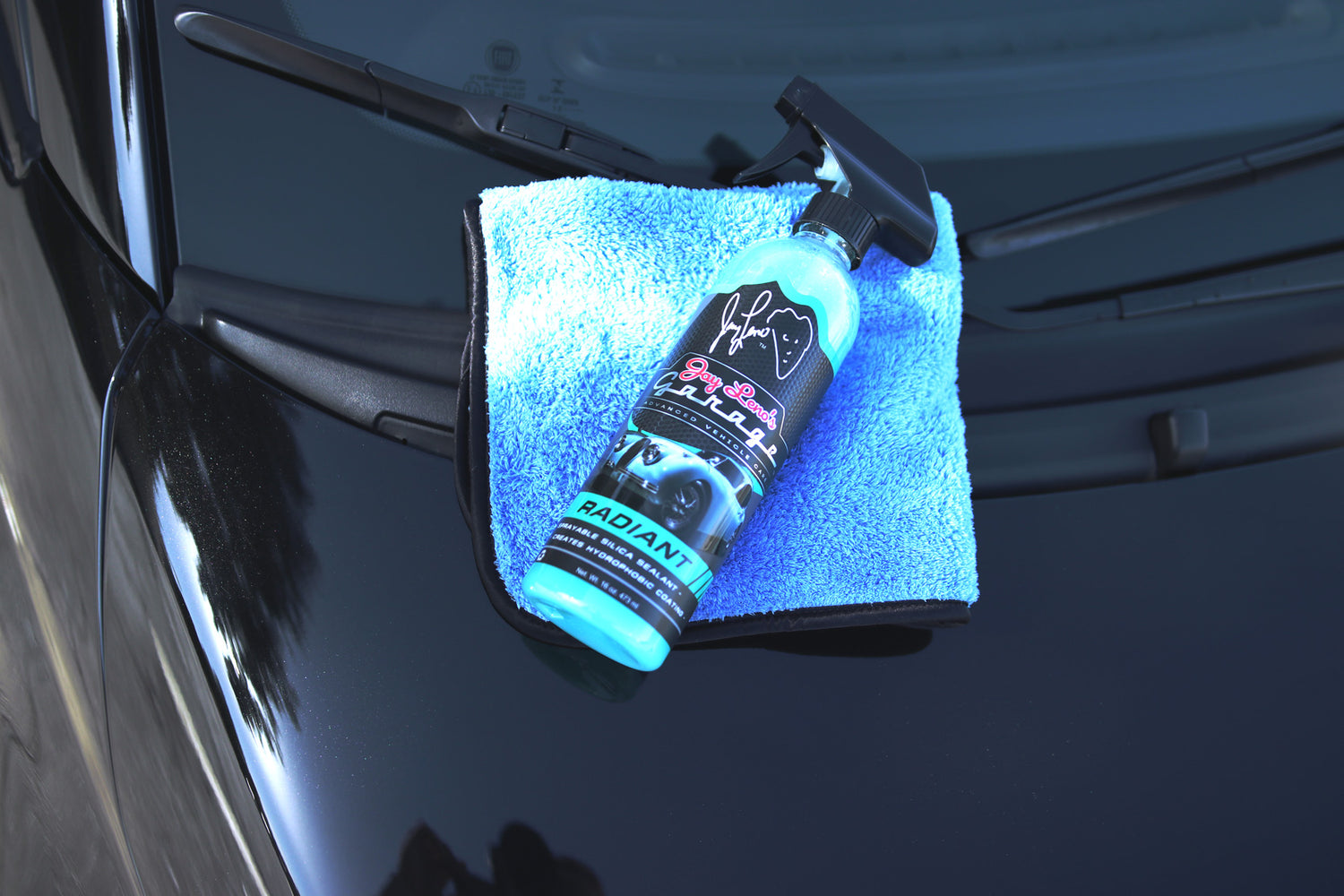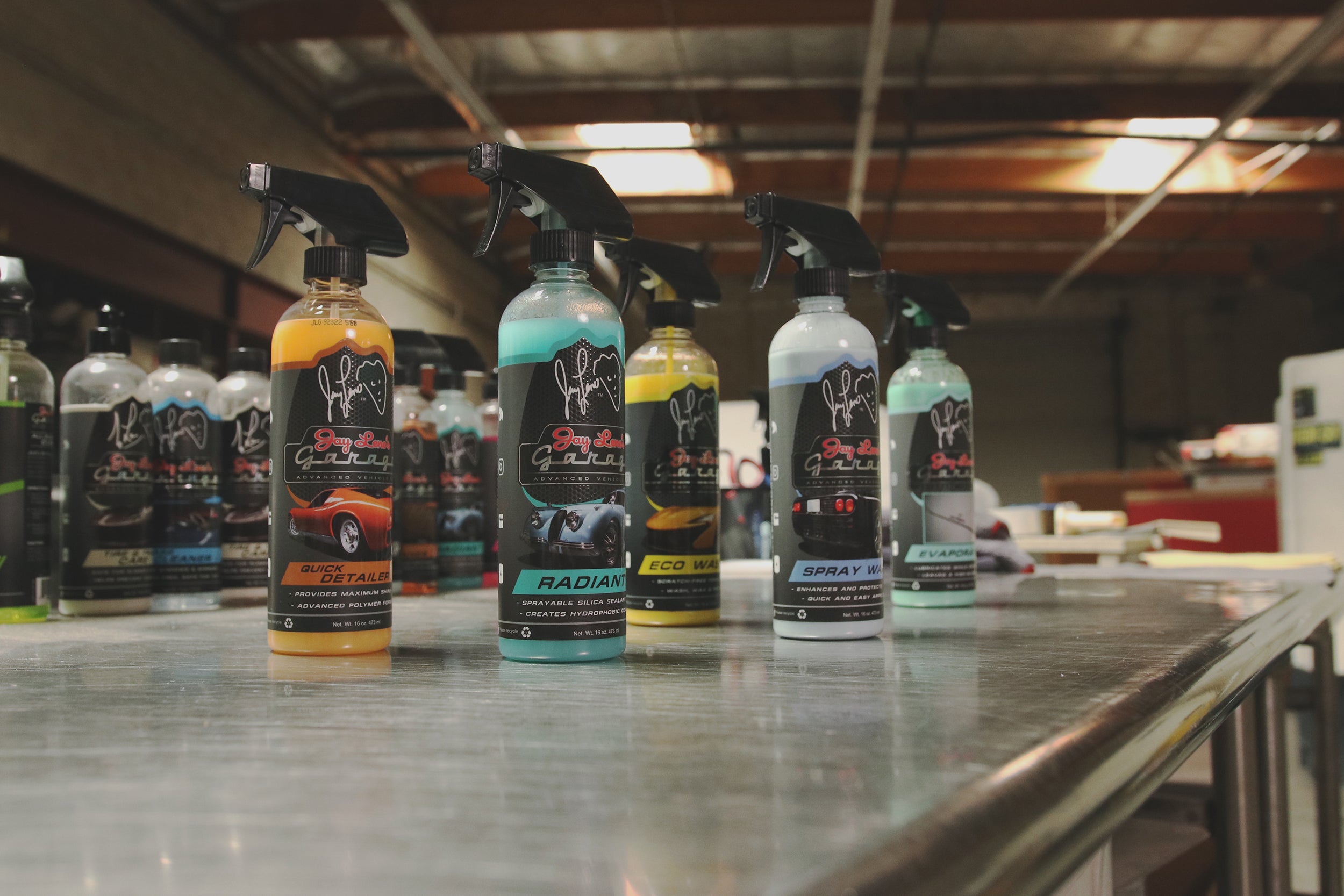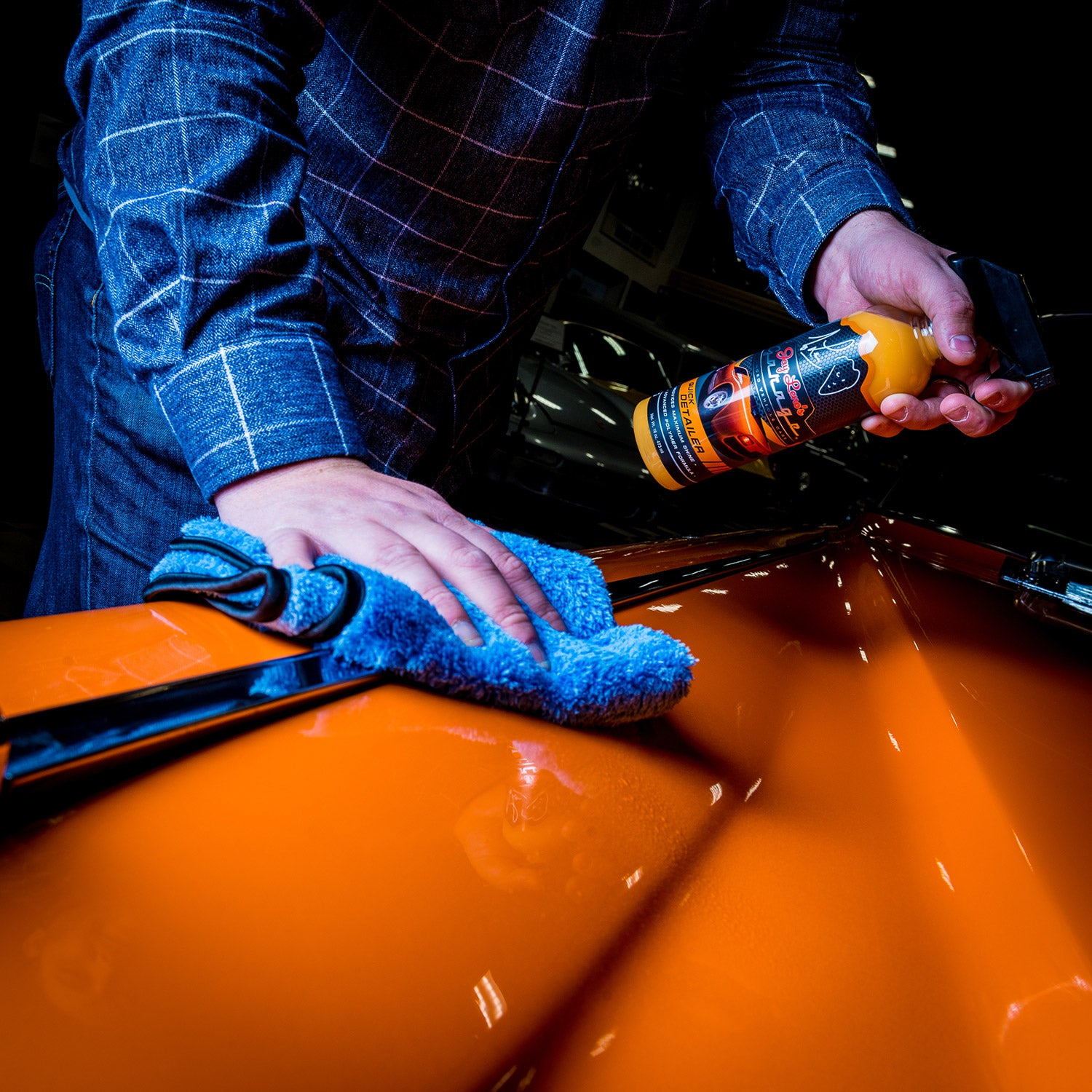The question gets asked a lot: what’s the difference between a ceramic coating and a wax (or sealant for that matter)? It makes sense that there’s confusion around the topic – terms like these are often used interchangeably and most people were taught to understand that a wax IS A sealant and both of them are a form of coating. In a lot of ways that’s true, but as detailing technology continues to evolve, paint protection materials have become more advanced and distinct differences between these terms have begun to emerge.
Waxes, sealants & ceramic coatings have distinct advantages and are specifically suited for different applications. In this write-up we’ll go over some of the common misconceptions, the definitions of each and hopefully help establish an understanding of how these terms are different and when it’s best to use each of them.
What is a wax?
Wax can be a diverse blend of materials that are referred to as "malleable solids" – basically a substance that can change form from a solid to a liquid at ambient or slightly elevated temperatures. Wax serves as a protective, sacrificial barrier between your cars paint and the environment. In the automotive world carnauba, montan and paraffin waxes are most commonly used, but there are synthetic variants as well.
The first thing to note is that wax you apply to your car is never in its 100% wax form. You’ll frequently see marketing messages that claim a product to be 100% carnauba wax, but this is a little misleading as it’s typically referring to the purity of the wax in a specific product. See the image below – this is what 100% carnauba wax looks like in its raw, refined form. As you can see, it’s too hard to be spreadable and provide the protection we’re looking for. To achieve the desired result we have to add solvents that the wax is soluble in. We’ll also blend in oils that provide lubrication along with scents & colorants. By blending different types of waxes together we can achieve different results like ease-of-use, clarity and color enhancement.

What is a sealant?
The term “sealant” is pretty ubiquitous. A paint sealant, in the past, has been a product that mimics a wax’s characteristics, but is made from synthetic material rather than organic materials. They were slightly more robust than a wax, but still suffered from some of the same short comings (susceptible to high temperatures and car washing soaps).
Often times, when it comes to paint protection, both wax & ceramics are referred to as a sealant.
What is a ceramic coating?
A more recent development in detailing technology has been ceramic-based paint protection. (You’ve probably heard numerous terms/names, most commonly ceramic coating, silica, quartz, silicone-dioxide or even SiO2). This new ceramic material acts very differently from a wax in the sense that it will actually generate a curing property once applied to a surface. This curing creates a chemical bond with the surface on which it’s being applied, in this case our car’s paint. Once they’re applied & cured, ceramic-based protectants are extremely resistant to water, soaps, and of course environmental pollutants.
Ceramic protectants (coatings) provide a much higher durability than wax. They resist heat, UV rays, environmental contaminants & harsh detergents much better than wax.
Wax on the other hand simply sits on top of the paint’s surface. It does not create the chemical bond like we find with ceramic coatings.
How should you apply wax?
If you choose to utilize wax for your paint-protection needs, we've got some general pointers for best practices. We suggest applying any kind of wax (whether it’s a spray, cream or paste) with an applicator pad. Also, it’s best to make sure you’re working in a shaded area and that the surface is cool to the touch. Working one panel at a time, apply a thin coat of wax with an applicator pad. Allow enough time for the wax to haze, usually 5-10 minutes. Then, after it has hazed, buff the surface to a beautiful shine with a soft microfiber towel. Repeat the process on each panel until you’ve finished the entire car.

How should you apply ceramic-based paint protection?
This can vary based on the type of coating you’re using. We suggest reading the application instructions thoroughly before applying any brand of ceramic protectant. If you’re using Jay's SiO2-based ceramic coating, Radiant, application is similar to using a detailing spray.
Again, work in a shaded area, then mist the panel with a few sprays of Radiant. With a soft microfiber towel, distribute Radiant across the entire panel, then flip the towel to a dry side and buff to a beautiful shine. We suggest allowing 30-60 minutes for Radiant to cure & bond with your vehicle’s paint. Once cured, you’ll have months of hydrophobic water-beading and dust repellency.
In the video above we show the hydrophobic properties of Radiant in action. It creates a super-slick surface that nothing wants to stick to, please it can provide months of protection without all of the "wax-on, wax-off" hassle.
When and how often should I apply a wax or ceramic?
Waxes & sealants are protectants - they should always be the last thing you apply to your vehicle's paint. How often really depends on the type of driving you do and the punishment your car’s paint endures. With wax, a good rule of thumb is once every 4-6 weeks for general-use cars that are parked in a garage or covered. You’ll want to step up the frequency if you live in an area with overly-harsh weather conditions, or if the vehicle spends a majority of time parked out in the elements.
Durability and length of protection are really where ceramics shine (pardon the pun). It can depend on the type of coating you choose & the conditions your car or truck lives in, but we typically see 3-4 months of protection from a coating like Radiant! That’s more than double the amount of time when compared to a wax. Some coatings even boast years of paint protection, but those can be a little more difficult to apply and we'd suggest consulting a professional if you choose this route.
Regardless of which method of paint protection you use, it's important to reiterate that durability will vary depending on your specific storage conditions & the environment your vehicle lives in.
For some, it might boil down to the simplest question: Which is better? Well, it’s honestly up to personal preference. When we get asked, our first response is typically "How is the car is used?"
If you’re headed to a car show or maybe a photo shoot, wax can be an excellent option. It provides a warm glow and depth to your vehicle’s painted surfaces, and will protect for a decent period of time.
However, if the car is your daily driver, sees lots of time on the road, maybe gets parked outdoors most of the day while you’re at work – you might want to consider switching to a ceramic coating for your protection needs. The ease of use paired with its low maintenance needs make it the clear choice for cars that get driven on a daily basis.
Can you "stack", or use both a wax and a ceramic together?
The easy answer is yes, you can. You could lay the ceramic-based protectant down first, let it cure and then apply a wax. However, we rarely suggest it. It’s a bit redundant, and the idea here is to reduce the amount of time & effort it takes to protect your investment. Plus, ceramic-based protectants are so slick that once they cure the wax will have trouble adhering to the surface anyway.
In the end, it’s easiest to think about wax and ceramic coatings as two different roads that lead to the same destination. They are different materials that perform the same task: protect your vehicle's exterior surfaces. Both provide a sacrificial layer that is intended to shield your car’s surface from sun exposure, moisture and environmental pollution. Wax is the old, winding 2-lane road that leads into town and ceramic is the new, 6-lane wide expressway that gets you there in half the time.
Hopefully this post helps clarify some of the confusion that surrounds waxes, sealants and now ceramics. If you have any questions that we may have missed, feel free to drop us a line at info@lenosgarage.com!




17 comments
Steve
I live out in Arizona and the sun really does a number on a cars paint. What is the best thing to use to help protect the paint from the heat and sun?? Thankyou.
I live out in Arizona and the sun really does a number on a cars paint. What is the best thing to use to help protect the paint from the heat and sun?? Thankyou.
Steve Price
How will Radiant work on a fiberglass boat?
How will Radiant work on a fiberglass boat?
Rick Mazur
JLG…Love the Quick Detailer….Just bought Radiant….My question is should I was the car first, clay, apply Radiant and then Quick Detailer… or can I put Radiant on top of Quick Detailer?
JLG…Love the Quick Detailer….Just bought Radiant….My question is should I was the car first, clay, apply Radiant and then Quick Detailer… or can I put Radiant on top of Quick Detailer?
Jose Perez
I just purchased a 2018 SL. How can I determine whether wax or sealant has been applied previously?
I just purchased a 2018 SL. How can I determine whether wax or sealant has been applied previously?
Greg Houlihan
I liked your website. If I want to apply a sealant how does a person remove the wax, if any, is on the vehicle? Thank you.
I liked your website. If I want to apply a sealant how does a person remove the wax, if any, is on the vehicle? Thank you.
Marvin
Are silica based sealants safe to use on gloss vinyl wrapped cars? If not what would be an alternative?
Thanks
Are silica based sealants safe to use on gloss vinyl wrapped cars? If not what would be an alternative?
Thanks
Gene Palmer
Getting a new car (Acura RDX) in a few days….what should I do before applying Radiant? Also will it stand up to commercial full service car washes?
Getting a new car (Acura RDX) in a few days….what should I do before applying Radiant? Also will it stand up to commercial full service car washes?
Jim
My car has a lot of black trim. How will it effect the trim? Will I need to tape off all the trim?
My car has a lot of black trim. How will it effect the trim? Will I need to tape off all the trim?
Steve
I have a 2002 Z3 convertible – which would you recommend for a more “mature” car?
I have a 2002 Z3 convertible – which would you recommend for a more “mature” car?
Rand Adams
I have XPel ding-protection film on the front of my vehicle. Can Radiant be used on XPel film?
I have XPel ding-protection film on the front of my vehicle. Can Radiant be used on XPel film?
Paul Cook
I bought a new RAV-4 in March of this year. The first thing I did was wash and wax it. I would like to start using the Radiant. How do I remove the wax, (It sounds like I should) before using Radiant?
I bought a new RAV-4 in March of this year. The first thing I did was wash and wax it. I would like to start using the Radiant. How do I remove the wax, (It sounds like I should) before using Radiant?
Jay Leno's Garage
Greg, that is an excellent question. Ideally, you would want to polish or refinish your car’s paint prior to applying a silica-based sealant. It’s not required, but would make the most sense from an order of operations stand point. If you did need to remove Radiant from your car’s paint AFTER you’ve applied it, the easiest way would be to use a light polishing compound and a finishing pad. You’ll know it’s removed once water sticks to the surface longer than a coated area. Hopefully that answers your question.
Greg, that is an excellent question. Ideally, you would want to polish or refinish your car’s paint prior to applying a silica-based sealant. It’s not required, but would make the most sense from an order of operations stand point. If you did need to remove Radiant from your car’s paint AFTER you’ve applied it, the easiest way would be to use a light polishing compound and a finishing pad. You’ll know it’s removed once water sticks to the surface longer than a coated area. Hopefully that answers your question.
Jay Leno's Garage
Dave, great question. We would suggest removing the wax coating before applying Radiant. To cure properly, Radiant needs to be in direct contact with the painted surface. If there’s a layer of wax in between Radiant and the paint, you won’t realize the benefits and long-term protection Radiant offers. Let us know if we can answer any other questions by reaching out to us at info@lenosgarage.com.
Dave, great question. We would suggest removing the wax coating before applying Radiant. To cure properly, Radiant needs to be in direct contact with the painted surface. If there’s a layer of wax in between Radiant and the paint, you won’t realize the benefits and long-term protection Radiant offers. Let us know if we can answer any other questions by reaching out to us at info@lenosgarage.com.
Jay Leno's Garage
Donny, thanks for the interest. To answer your question, the 16oz. bottle of Radiant is $29.99. There’s some pretty high-quality raw materials that make up Radiant, so the price is slightly higher because of that. Let us know if we can answer any other questions by reaching out to us at info@lenosgarage.com.
Donny, thanks for the interest. To answer your question, the 16oz. bottle of Radiant is $29.99. There’s some pretty high-quality raw materials that make up Radiant, so the price is slightly higher because of that. Let us know if we can answer any other questions by reaching out to us at info@lenosgarage.com.
Greg Raven
If the silicone sealant bonds with the paint, does that make it more difficult to refinish the vehicle?
If the silicone sealant bonds with the paint, does that make it more difficult to refinish the vehicle?
Donny Blackburn
I have been using a few of Jay’s labeled products for a while. I like the yellow detailer. This new Radiant is something different it appears. Too much explanation is given without saying exactly what you get for $29XX. Is it one gallon plus a 16oz spray of the product? Or is it $29 plus for only the 16oz? Does it replace the yellow detailer? I may have missed something but it doesn’t seem clear what you get for the price.
Donny
Prescott, AZ (a few Porsches)
I have been using a few of Jay’s labeled products for a while. I like the yellow detailer. This new Radiant is something different it appears. Too much explanation is given without saying exactly what you get for $29XX. Is it one gallon plus a 16oz spray of the product? Or is it $29 plus for only the 16oz? Does it replace the yellow detailer? I may have missed something but it doesn’t seem clear what you get for the price.
Donny
Prescott, AZ (a few Porsches)
DAVE
I just waxed my vette, can i use the sealant now
I just waxed my vette, can i use the sealant now